This is my first entry for steemSTEM. I didn't know about the project and the big community behind it until the last week. So I'm so happy this empowerment of science is happening here in Steemit, and also I want to contribute. Today I want to tell you about some curious electric motor prototypes that I had the opportunity to see when I was in university. Although they have not real applications because they need much power to work, they are important for educational purposes in order to discuss the behavior of electromagnetism.
Motor 1: Single Coil spinning (no magnets)
This motor is very simple, it is a universal motor, meaning that it can be powered by any type of current, AC or DC. When you search for a universal motor you usually see that it has 2 coils, one of them used to generate a uniform magnetic field, and another one that uses this magnetic field for the movement (
example). Well, the motor of the figure is very simple,
it only uses one single coil which generates the magnetic field and at the same time uses it to rotate.
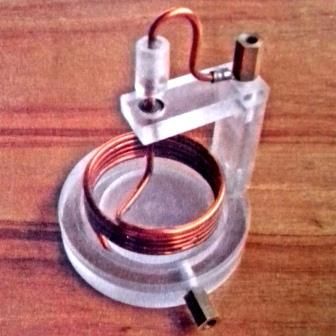
Source: Reference [1]
Construction: As you can see in the figure, there is a coil that has free movement on its central axis. One of the ends of the coil goes to the central axis and then it is connected to the top of the circuit. The other end goes to a circular channel of mercury liquid, which touches the connector on the bottom. The mercury helps to close the circuit no matter the position of the coil.
How it works?
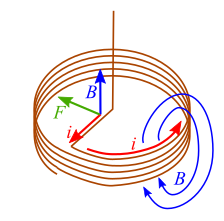
Own authorship
In brief, when it is powered the current charges the coil generating a magnetic field. This magnetic field acts over the axial current that goes from the center to the coil, and then a force is produced. Since the coil has free movement it will start to rotate.
Let's see some calculations. First, consider that the current is flowing from the top to the bottom. The Ampere's Law states that any current generates a magnetic field around it. The integrated magnetic field around a loop is proportional to the current passing through the loop. That loop can be any artificial path that we want consider:

In the figure, the current comes from the top and next flows anticlockwise. This produces a magnetic field flowing inside the coil from the bottom to the top. If we select a rectangular path which passes through the center of the coil, its easy to see that the magnetic field is (see
details here):

where

is the permeability,
n the number of turns of the coil, and
I the current.
Next, see that this magnetic field is passing through the current flowing from the central axis to the outside. Since the current is perpendicular to the magnetic field it experiences a
Lorenz Force:

Using the right-hand rule we see that the direction of this force causes the coil to turn clockwise. From the result, we see that the force is proportional to the number of turns of the coil and also proportional to the current squared.
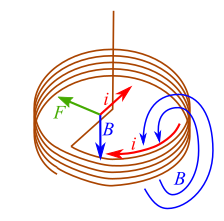
Own authorship
Now let's consider a current flowing from the bottom to the top. In this case, the current in the coil is flowing clockwise and therefore the magnetic field generated is flowing from the top to the bottom. Using the right-hand rule again we found that the direction of the force is the same as previous one. For this reason, it can be powered with AC, because no matter the direction of the current the force has the same direction. That is, the movement responds to the geometry of the circuit.
It turns clockwise
no matter the direc-
tion of the current
It is important to mention that the magnetic field involved in the Lorentz Force can be constant, like in this case. We would need a time-varying magnetic field if we wanted to induce a current in another coil isolated from the circuit (Faraday's Law of induction), but this is not the case.
Also, mention that there are another forces generated by the coil itself because the current in the circular path is always perpendicular to the magnetic field. However, all these forces point out the coil and the sum of all them cancels the effective force. Then they are neglected.
Simulation in python
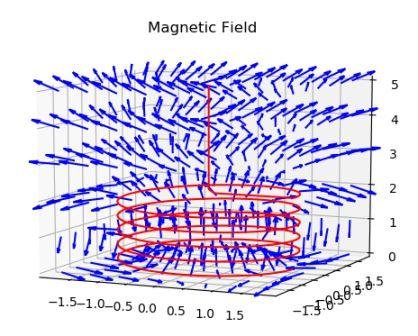
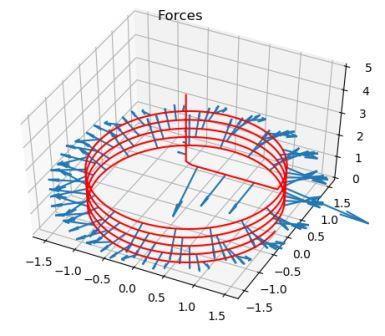
Own authorship
The simulation of this circuit consists of two parts: First, the calculation of the magnetic field over the space, where it is more convenient to use
Biot-Savart Law. And the second part is the calculation of the forces using the Lorentz Force.
I simulated it in python. The code available to anyone who wants to test it. You can read and download it on Github.
The current is flowing from the top to the bottom. As you can see in the first figure, inside the coil the magnetic field is flowing from the bottom to the top and moves backward if it is outside. The second figure shows us the generated forces. All the forces around the circles have the same magnitude then they are canceled and the effective force is that which is exerted on the lateral wire, which produces the rotary movement.
Motor 2: Twin spirals

Source: Reference [1]
In the previous one, we saw that the direction of rotation does not depend on the direction of the current but its geometry. Following this idea, the Twin spirals refers to
two spirals which have different directions, one of them to turn clockwise and another to turn anticlockwise.
As you can see in the figure, they are two discs which propagate the current describing logarithmic curves (6 in total). Between the discs, there are rolling bearings to give free movement to them and unlike the previous one, there is an axis both above and below.
The magnetic field and forces generated may be difficult to visualize but the concept is the same: When the current describes the logarithmic curve there is a magnetic field associated with it. This field act over the spiral generating forces, which have a different direction in each spiral.
Stator and Rotor?
The concepts of rotor and
stator are not universal
When we study about motors we constantly see two figures involved: The stator and the rotor. The stator remains fixed and the rotor is the moving part. Twin spirals try to confront this conception showing that the movement is always relative. If the two spirals are rotating, which is the rotor? which of two is stator? there is no response, only we can say is that each one is rotating with respect to the other. In this sense, we can conclude that the concepts of rotor and stator are not universal although they are useful for the vast majority of motors.
Simulation in python
In order to simplify the model, the simulation has 4 branches, and the rolling bearings have been replaced by vertical wires to connect the two discs. Additionally, this algorithm needs to contemplate that the current are divided by 4 when go to each branch.
You can consult the code here
.
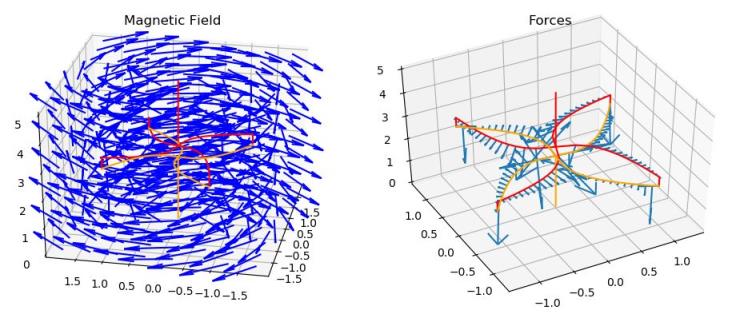
Own authorship
I drew the top spiral in red and the bottom spiral in orange to distinguish them better. The current is flowing from the top to the bottom. Then it creates a magnetic field rotating clockwise around the vertical axis. Inside the spirals, the magnetic field has different directions difficult to visualize in the figure.
The important part is the force generated. On every point in the top spiral (red) a force was generated to rotate anticlockwise. On the other hand, the bottom spiral (orange) is influenced by forces rotating clockwise. Additionally, there are some curious forces on the rolling bearings pointing down, but without much application, since they do not have free movement down.
Motor 3: The Wheel
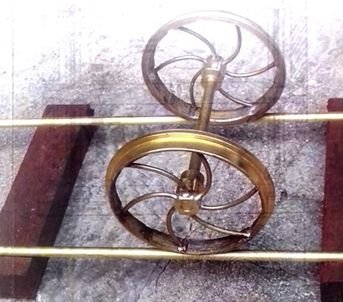
Source: Reference [1]
I don't know if it can be called motor or not, but its concept is very interesting and unique. Just take two spirals like the previous one, but this time put them in the same direction and join them by a central axis. The spirals are inscribed in a circle, so that we have 2 wheels linked by an axis. The wheels are on metal rails where they are energized.
This wheel rotates
energizing the rails
This concept differs a bit from the previous two because the current enters the ends of one wheel, flow towards the central axis (through the logarithmic curves), and describes the opposite on the other wheel, to finally close the circuit. This is really interesting because as we demonstrated above it does not matter much where the current flows. The important part is the geometry of the circuit. As the two wheels have the same direction then they will start to rotate over the rail.
Simulation in python
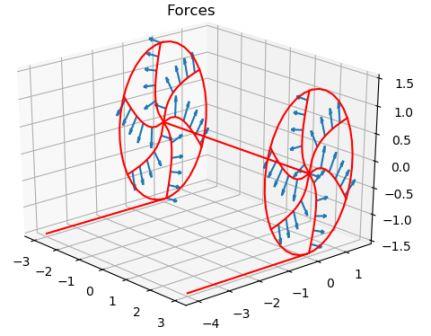
Own authorship
The figure at the right represents the simulation of this circuit. The current enters from the line of the right and come back from the left side. For a better visualization, I have hidden the forces over the circumference, the axis, and the rails. Also, the forces are normalized because my intention is to show the direction of movement. As you can see, all forces work together to rotate the wheel, which has free movement over the rail.
You can consult the code of the simulation here
Final notes
All these prototypes are creations of Professor Albert Serra-Valls (currently working at
Innovem), with whom I had the opportunity to make long conversations and discussions about electromagnetism. In his conception of electromagnetism, he proposes that the movement present in these prototypes can also be explained through
the conservation of the angular momentum of the charges.
The work that I have developed in this post is a response to all these talks I had with him since it is a subject that I am very passionate about.
References
- Alberto Serra-Valls. El motor turbo electrodinámico y la nueva ley de inducción. Instituto Venezolano de Investigaciones Científicas, 2009.
- Wikipedia - Maxwell's Equations













Muy buen artículo, junto con las simulaciones dan un panorama muy completo. Buen artículo Julián.
Muchas gracias @zenkly
Muy interesante tu post Julián! La mayoría no tiene ni idea de cómo operan estas leyes físicas sobre nuestro mundo y para la mayoría no saberlo no hace la diferencia, pero eso depende del tamaño del mundo donde queremos vivir y cuando logramos comprender cosas como está definitivamente nuestro cerebro y nuestro mundo se expanden , te ánimo a que sigas compartiendo contenido sobre ciencias, son los post que más disfruto leee, saludos!
Te leo directamente desde la etiqueta #steemfamilyhi
Muchas gracias Jesús. La ciencia ha sido algo que siempre me ha gustado y como tú dices, hace que nuestro mundo y cerebro se expandan a nuevos horizontes.
Un saludo.
Hey hermano buen post, me encanta cómo estructuras tú contenido. Cuentas con mi apoyo para tus publicaciones. Lo más interesante deben ser las conversaciones que mantuviste con albert y te inspiraron a realizar el contenido. También me gustaron las imágenes de tú autoria. un gran saludo. #steemfamilyhi
Muy geniales las gráficas . Ya encontré el código fuente! Saludos
excelentes publicaciones tienes mi apoyo
Excellent post friend, it is seen that it is a very complete material, I am very knowledgeable, although I am frank about subject I know very little, added to that I wanted to thank you for the support you gave me with the post dedicated to my daughter María Suarez , I thank you with all my heart and it is more to tell you that you can count on me, with my upvote and my comments, here you have a friend, blessings for you and your family and much success in life.
Thank you very much jorge. Blessings for you and your family :)
Excelente post jga...interesantisimo...
You got a 8.04% upvote from @postpromoter courtesy of @jga!
Want to promote your posts too? Check out the Steem Bot Tracker website for more info. If you would like to support the development of @postpromoter and the bot tracker please vote for @yabapmatt for witness!